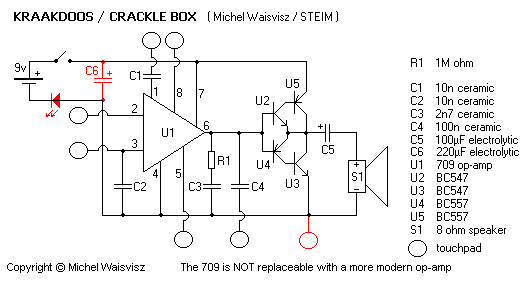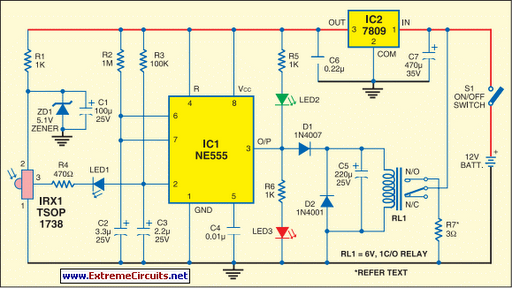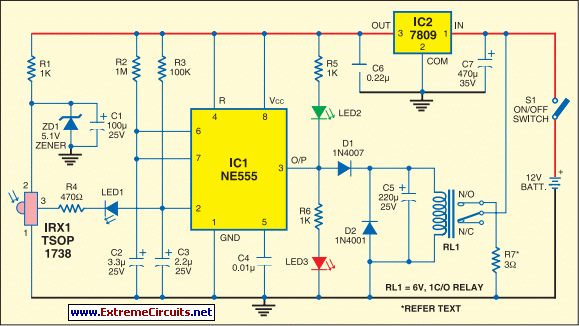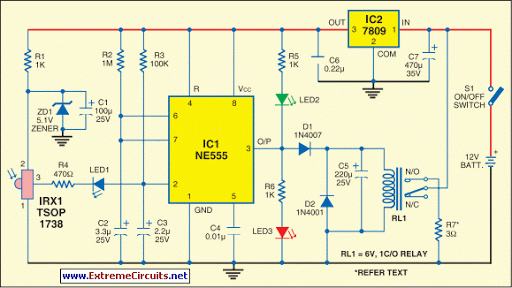
crack lebox

After gathering information about the cracklebox, a decision was made to build one in the spring of 2007. The cracklebox is a solid-state op-amp circuit designed to facilitate interaction through bodily contact. It features several touch points that allow users to insert their skin impedance into the circuit, creating crackling and squelching sounds through feedback loops. The device utilizes an LM709 op-amp, which is becoming increasingly difficult to obtain. Some were sourced online at a reasonable price to share with the dorkbot pdx community. This version is based on the alternate kraakadoos schematic. The schematic was recreated using PCB software, and enhancements were made, including a switched 1/4" line-out, an envelope signal LED, and an additional jumper. A PCB was designed manually, and several boards were etched, populated, and assembled into functional crackleboxes. Three crackleboxes were built by hand in the spring of 2007, utilizing home-fabricated PCBs, hand soldering, and rudimentary woodworking. One of the boxes was decorated, while the others were finished with a simple black spray coat. Demo reels were recorded to showcase a fraction of the cracklebox's capabilities, but these are not complete songs. The output signal is strong, but it can be mixed effectively. The crackleboxes exhibit high sensitivity, resulting in varied playing experiences for different users. Certain touch pads provide minimal variation in output sound, while a couple of pads account for the majority of the sound. When the line-out is connected, the output characteristics change, and the circuit may pick up one or more AM radio stations.
The cracklebox is an innovative electronic instrument that leverages the properties of skin impedance to create unique soundscapes. The core of its operation is based on the LM709 op-amp, a classic operational amplifier that has been widely used in various applications. This op-amp is configured in a non-inverting amplifier setup, which allows for high input impedance and low output impedance, making it ideal for this type of interactive device.
The circuit includes multiple touch points, which are essentially conductive pads that users can touch to influence the circuit's behavior. These pads are strategically placed to allow for different levels of interaction, with some pads designed to produce more pronounced effects than others. The sensitivity of the circuit means that even slight variations in skin contact can lead to significant changes in sound output, resulting in a highly expressive instrument.
The addition of a switched 1/4" line-out allows the cracklebox to be connected to external audio equipment, such as mixers or amplifiers. This feature enhances its usability in live performances or recordings. The envelope signal LED provides visual feedback about the output signal's amplitude, allowing users to gauge their playing dynamics.
The design process involved creating a custom PCB, which not only streamlined the assembly process but also ensured a compact and efficient layout of components. The hand-etched boards reflect a DIY ethos, which is common in experimental audio electronics. The aesthetic choices, including the painted and spray-coated finishes, contribute to the instrument's unique character.
In terms of sound, the cracklebox is capable of producing a wide range of effects, from subtle crackles to intense squelches, depending on how the user interacts with the touch points. The ability to pick up AM radio frequencies when connected to the line-out adds an unexpected layer of complexity, further enriching the sound palette available to the user. This phenomenon is not uncommon in sensitive analog circuits and can be exploited creatively in performances.
Overall, the cracklebox exemplifies the intersection of electronics and art, providing users with a platform for exploration and creativity in sound production. Its design and functionality encourage experimentation, making it a valuable addition to any electronic musician's toolkit.After casually assembling information about the cracklebox, I finally decided to build one in the spring of 2007. In short, the cracklebox is a solid state op-amp chip that has its inputs and outputs wired in a clever circuit in such a way that facilitates playing of the circuit with bodily contact.
There are several touch points that allow the u ser to insert his own skin impedance into the circuit to create crackle and squelching sounds with feedback loops. The device used for the cracklebox in this configuration is particularly sensitive, and allows a considerably broad dynamic range.
The design calls for an LM709 op-amp, which is now quite aging and getting progressively difficult to obtain. I found some online relatively cheaply and ordered some to share with the dorkbot pdx dorks. I based this version on the alternate kraakadoos schematic. . I recreated the schematic in some PCB software and added a switched 1/4" line-out, envelope signal LED, and that 7th jumper.
I then designed a PCB by hand and etched a few boards which I then populated and built into working crackleboxen. In the spring of 2007, I built 3 crackleboxes by hand using home fabricated PCBs, hand soldering, and terrible woodworking.
In the photos below, one of the boxes has been decorated/painted. The other two are finished in a simple black spray coat. These little [long ] clips were recorded merely as "demo reels" to show off a fraction of what the cracklebox can produce. They are not songs or even complete works. The output signal can be pretty hot, but run through a mixer will work just fine. The crackleboxes are really fantastically sensitive, and playing is different for each person. There are a few touch pads that provide little or no change to the output sound (is this a design issue ).
There are 2 or so pads that seem to account for most of the sound. When the line-out is connected, the output characteristics will change and the circuit (at least in my setup!) often picks up one or more AM radio stations. 🔗 External reference
The cracklebox is an innovative electronic instrument that leverages the properties of skin impedance to create unique soundscapes. The core of its operation is based on the LM709 op-amp, a classic operational amplifier that has been widely used in various applications. This op-amp is configured in a non-inverting amplifier setup, which allows for high input impedance and low output impedance, making it ideal for this type of interactive device.
The circuit includes multiple touch points, which are essentially conductive pads that users can touch to influence the circuit's behavior. These pads are strategically placed to allow for different levels of interaction, with some pads designed to produce more pronounced effects than others. The sensitivity of the circuit means that even slight variations in skin contact can lead to significant changes in sound output, resulting in a highly expressive instrument.
The addition of a switched 1/4" line-out allows the cracklebox to be connected to external audio equipment, such as mixers or amplifiers. This feature enhances its usability in live performances or recordings. The envelope signal LED provides visual feedback about the output signal's amplitude, allowing users to gauge their playing dynamics.
The design process involved creating a custom PCB, which not only streamlined the assembly process but also ensured a compact and efficient layout of components. The hand-etched boards reflect a DIY ethos, which is common in experimental audio electronics. The aesthetic choices, including the painted and spray-coated finishes, contribute to the instrument's unique character.
In terms of sound, the cracklebox is capable of producing a wide range of effects, from subtle crackles to intense squelches, depending on how the user interacts with the touch points. The ability to pick up AM radio frequencies when connected to the line-out adds an unexpected layer of complexity, further enriching the sound palette available to the user. This phenomenon is not uncommon in sensitive analog circuits and can be exploited creatively in performances.
Overall, the cracklebox exemplifies the intersection of electronics and art, providing users with a platform for exploration and creativity in sound production. Its design and functionality encourage experimentation, making it a valuable addition to any electronic musician's toolkit.After casually assembling information about the cracklebox, I finally decided to build one in the spring of 2007. In short, the cracklebox is a solid state op-amp chip that has its inputs and outputs wired in a clever circuit in such a way that facilitates playing of the circuit with bodily contact.
There are several touch points that allow the u ser to insert his own skin impedance into the circuit to create crackle and squelching sounds with feedback loops. The device used for the cracklebox in this configuration is particularly sensitive, and allows a considerably broad dynamic range.
The design calls for an LM709 op-amp, which is now quite aging and getting progressively difficult to obtain. I found some online relatively cheaply and ordered some to share with the dorkbot pdx dorks. I based this version on the alternate kraakadoos schematic. . I recreated the schematic in some PCB software and added a switched 1/4" line-out, envelope signal LED, and that 7th jumper.
I then designed a PCB by hand and etched a few boards which I then populated and built into working crackleboxen. In the spring of 2007, I built 3 crackleboxes by hand using home fabricated PCBs, hand soldering, and terrible woodworking.
In the photos below, one of the boxes has been decorated/painted. The other two are finished in a simple black spray coat. These little [long ] clips were recorded merely as "demo reels" to show off a fraction of what the cracklebox can produce. They are not songs or even complete works. The output signal can be pretty hot, but run through a mixer will work just fine. The crackleboxes are really fantastically sensitive, and playing is different for each person. There are a few touch pads that provide little or no change to the output sound (is this a design issue ).
There are 2 or so pads that seem to account for most of the sound. When the line-out is connected, the output characteristics will change and the circuit (at least in my setup!) often picks up one or more AM radio stations. 🔗 External reference


